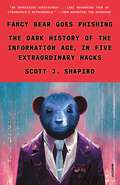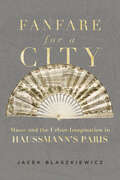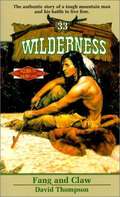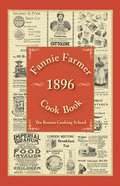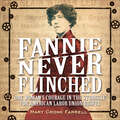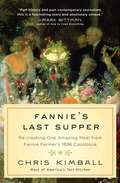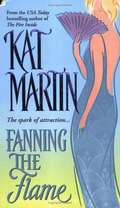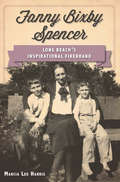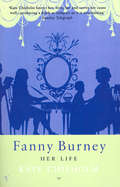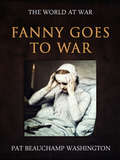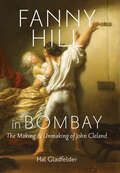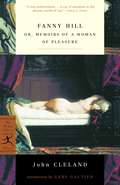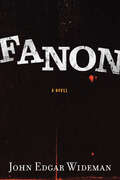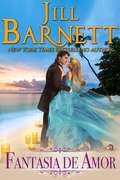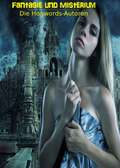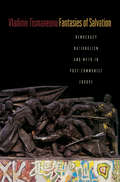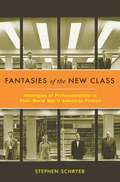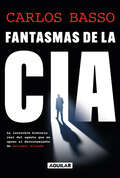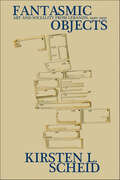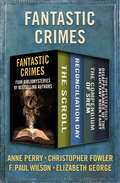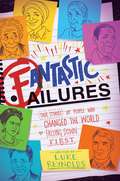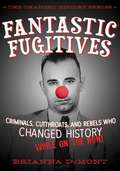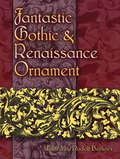- Table View
- List View
Fancy Bear Goes Phishing: The Dark History of the Information Age, in Five Extraordinary Hacks
by Scott J. Shapiro“Unsettling, absolutely riveting, and—for better or worse—necessary reading.” —Brian Christian, author of Algorithms to Live By and The Alignment ProblemAn entertaining account of the philosophy and technology of hacking—and why we all need to understand it.It’s a signal paradox of our times that we live in an information society but do not know how it works. And without understanding how our information is stored, used, and protected, we are vulnerable to having it exploited. In Fancy Bear Goes Phishing, Scott J. Shapiro draws on his popular Yale University class about hacking to expose the secrets of the digital age. With lucidity and wit, he establishes that cybercrime has less to do with defective programming than with the faulty wiring of our psyches and society. And because hacking is a human-interest story, he tells the fascinating tales of perpetrators, including Robert Morris Jr., the graduate student who accidentally crashed the internet in the 1980s, and the Bulgarian “Dark Avenger,” who invented the first mutating computer-virus engine. We also meet a sixteen-year-old from South Boston who took control of Paris Hilton’s cell phone, the Russian intelligence officers who sought to take control of a US election, and others.In telling their stories, Shapiro exposes the hackers’ tool kits and gives fresh answers to vital questions: Why is the internet so vulnerable? What can we do in response? Combining the philosophical adventure of Gödel, Escher, Bach with dramatic true-crime narrative, the result is a lively and original account of the future of hacking, espionage, and war, and of how to live in an era of cybercrime.Includes black-and-white images
Fanfare for a City: Music and the Urban Imagination in Haussmann's Paris
by Jacek BlaszkiewiczFanfare for a City invites us to listen to the sounds of Paris during the Second Empire (1852–1870), a regime that oversaw dramatic social change in the French capital. By exploring the sonic worlds of exhibitions, cafés, streets, and markets, Jacek Blaszkiewicz shows how the city's musical life shaped urban narratives about le nouveau Paris: a metropolis at a crossroads between its classical, Roman past and its capitalist, imperial future. At the heart of the narrative is "Baron" Haussmann, the engineer of imperial urbanism and the inspiration for a range of musical responses to modernity, from the enthusiastic to the nostalgic. Drawing on theoretical approaches from historical musicology, urban sociology, and sound studies to shed light on newly surfaced archival material, Fanfare for a City argues that urbanism was a driving force in how nineteenth-century music was produced, performed, and policed.
Fang And Claw (Wilderness, # #33)
by David ThompsonTo survive in the untamed wilderness a man needs all the friends he can get. No one can battle the continual dangers for long on his own. Even a fearless frontiersman like Nate King needs help now and then and he's always ready to give it when it's needed. So when an elderly Shoshone warrior comes to Nate asking for help, Nate agrees to lend a hand-no matter how strange the request may be. The old warrior knows he doesn't have long to live and he wants to die in the remote canyon where his true love was killed many years before, slain by a giant bear straight out of Shoshone myth. No Shoshone will dare accompany the old warrior, so he and Nate will brave the dreaded canyon alone. And as Nate soon learns the hard way, some legends are far better left undisturbed.
Fannie Farmer 1896 Cook Book: The Boston Cooking School
by Fannie Merritt FarmerA classic bestseller for over a century, the Fannie Farmer 1896 Cook Book contains an incredible offering of 1,380 recipes, from boiling an egg to preparing a calf’s head. Farmer’s instructions also go beyond recipes to include how to set the table for proper tea, full menu ideas for holiday dinners, housekeeping tips, and so much more. This book is known for pioneering the standardization of measurements in recipe instructions, which made the creation of better meals possible for even the most inexperienced of cooks. Farmer’s thorough text is chock full of fabulous Americana for cooks and non-cooks alike. This book is a great buy for cooks who want to get back to basics and enjoy the pleasures of traditional American cooking. Cooks who think they've done it all will discover classic recipes to share with friends and family, and total beginners will be comfortable with Farmer’s clear instructions for even the most basic meal prep. The Fannie Farmer Cook Book will be a valued addition to your cookbook collection.
Fannie Never Flinched: One Woman's Courage in the Struggle for American Labor Union Rights
by Mary Cronk FarrellFannie Sellins (1872–1919) lived during the Gilded Age of American Industrialization, when the Carnegies and Morgans wore jewels while their laborers wore rags. Fannie dreamed that America could achieve its ideals of equality and justice for all, and she sacrificed her life to help that dream come true. Fannie became a union activist, helping to create St. Louis, Missouri, Local 67 of the United Garment Workers of America. She traveled the nation and eventually gave her life, calling for fair wages and decent working and living conditions for workers in both the garment and mining industries. Her accomplishments live on today. This book includes an index, glossary, a timeline of unions in the United States, and endnotes.
Fannie's Last Supper: Re-creating One Amazing Meal from Fannie Farmer's 1896 Cookbook
by Christopher KimballIn the mid-1990s, Chris Kimball moved into an 1859 Victorian townhouse on the South End of Boston and, as he became accustomed to the quirks and peculiarities of the house and neighborhood, he began to wonder what it was like to live and cook in that era. In particular, he became fascinated with Fannie Farmer's Boston Cooking-School Cook Book. Published in 1896, it was the best-selling cookbook of its age-full of odd, long-forgotten ingredients, fascinating details about how the recipes were concocted, and some truly amazing dishes (as well as some awful ones).In Fannie's Last Supper, Kimball describes the experience of re-creating one of Fannie Farmer's amazing menus: a twelve-course Christmas dinner that she served at the end of the century. Kimball immersed himself in composing twenty different recipes-including rissoles, Lobster À l'AmÉricaine, Roast Goose with Chestnut Stuffing and Jus, and Mandarin Cake-with all the inherent difficulties of sourcing unusual animal parts and mastering many now-forgotten techniques, including regulating the heat on a coal cookstove and boiling a calf's head without its turning to mush, all sans food processor or oven thermometer. Kimball's research leads to many hilarious scenes, bizarre tastings, and an incredible armchair experience for any reader interested in food and the Victorian era. Fannie's Last Supper includes the dishes from the dinner and revised and updated recipes from The Boston Cooking-School Cook Book. A culinary thriller. it offers a fresh look at something that most of us take for granted-the American table.
Fanning the Flame
by Katherine MartinLondon is abuzz with the latest scandal. A young ward has been living under the roof of a wealthy nobleman old enough to be her father. Suddenly he's murdered and she's the only suspect.
Fanny Bixby Spencer: Long Beach's Inspirational Firebrand
by Marcia Lee HarrisThe last daughter born to Jotham Bixby, the "Father of Long Beach," Fanny Bixby Spencer (1879-1930) carved her own singular and eccentric path across California history. Born to wealth and power, she chose a boldly independent, egalitarian lifestyle in an age when women's lives were largely confined to domesticity. Fanny served with the Long Beach Police Department as America's first policewoman. She was a founder of the city of Costa Mesa in Orange County. Her humanitarian efforts reached across ethnicities and social standing. Yet beyond her civic accomplishments, Fanny was provocative as a poet, artist, pacifist, suffragist, child advocate, foster mother and humanitarian. Marcia Lee Harris captures this fascinating woman's remarkable life, enhanced by Fanny's own poetry and soulful reflections.
Fanny Burney: Her Life
by Kate ChisholmFanny Burney (1752-1840) is best known as the author of EVELINA, one of the most engaging novels of the eighteenth century. But for much of her long life, she was also an incomparable diarist, witnessing both the madness of George III and the young Queen Victoria's coronation. To read the journals she kept from the age of sixteen is to step back into Georgian England, meeting Dr Johnson, Garrick and Reynolds, being chased round the gardens of Kew Palace by the King. . . She was lady-in-writing to Queen Charlotte; she married an aristocratic emigre from the French Revolution and had her first and only child when she was forty-two; she was in Paris as Napoleon's armies marshalled against England, and in Brussels she heard the muffled guns, and watched the wounded being carried back from Waterloo. Kate Chisholm's delightful biography, incorporating the latest research and illustrate with unusual portraits and drawings, is lively, funny, shocking, informative and deeply moving; it paints a vivid portrait of a woman of great talent, against the changing background of England and France, a culture and an age.
Fanny Goes to War (The World At War)
by Pat WashingtonPublished in 1918, this is a personal account of (Catherine) Marguerite Beauchamp Waddell, Mrs. Washington, a member of The First Aid Nursing Yeomanry, which was founded in 1910 and now numbers roughly about four hundred voluntary members. (Google)
Fanny Hill in Bombay: The Making & Unmaking of John Cleland
by Hal GladfelderA study of the life and work of the notorious English novelist.John Cleland is among the most scandalous figures in British literary history, both celebrated and attacked as a pioneer of pornographic writing in English. His first novel, Memoirs of a Woman of Pleasure, or Fanny Hill, is one of the enduring literary creations of the eighteenth century, despite over two hundred years of legal prohibition. Yet the full range of his work is still too little known.In this study, Hal Gladfelder combines groundbreaking archival research into Cleland’s tumultuous life with incisive readings of his sometimes extravagant, sometimes perverse body of work, positioning him as a central figure in the development of the novel and in the construction of modern notions of authorial and sexual identity in eighteenth-century England.Rather than a traditional biography, Fanny Hill in Bombay presents a case history of a renegade authorial persona, based on published works, letters, private notes, and newly discovered legal testimony. It retraces Cleland’s career from his years as a young colonial striver with the East India Company in Bombay through periods of imprisonment for debt and of estrangement from collaborators and family, shedding light on his paradoxical status as literary insider and social outcast.As novelist, critic, journalist, and translator, Cleland engaged with the most challenging intellectual currents of his era yet at the same time was vilified as a pornographer, atheist, and sodomite. Reconnecting Cleland’s writing to its literary and social milieu, this study offers new insights into the history of authorship and the literary marketplace and contributes to contemporary debates on pornography, censorship, the history of sexuality, and the contested role of literature in eighteenth-century culture.“Cleland’s life story is a puzzle with many pieces still missing. But Gladfelder’s careful, painstaking reconstructions have brought the fascinating picture into much clearer focus.” —Choice“Anyone interested in the history of pornography or Cleland cannot afford to be without this study of the writer and his work.” —Julie Peakman, Times Literary Supplement (UK)“Innovative, adventurous, and exciting. Gladfelder has given us a new and, for eighteenth-century studies, a newly significant and central John Cleland—a writer whose notoriety as author of the first pornographic novel in English has until now overshadowed a long, varied, and remarkable career as colonial administrator, projector, jailbird, bookseller’s hack, alleged sodomite, translator, reviewer, philologist, and author of numerous original works beyond the Memoirs. . . . An exemplary—an unusual and immensely enabling—combination of painstaking archival and other historical research and analytic, expository flair. The scholarship is formidable throughout.” —Thomas Keymer, University of Toronto
Fanny Hill: or, Memoirs of a Woman of Pleasure (Modern Library Classics)
by John Cleland Gary GautierFanny Hill, shrouded in controversy for most of its more than 250-year life, and banned from publication in the United States until 1966, was once considered immoral and without literary merit, even earning its author a jail sentence for obscenity.The tale of a naïve young prostitute in bawdy eighteenth-century London who slowly rises to respectability, the novel-and its popularity-endured many bannings and critics, and today Fanny Hill is considered an important piece of political parody and sexual philosophy on par with French libertine novels.This uncensored version is set from the 1749 edition and includes commentary by Charles Rembar, the lawyer who defended the novel in the 1966 U.S. Supreme Court case, and newly commissioned notes.
Fanon: A Novel
by John Edgar WidemanA philosopher, psychiatrist, and political activist, Frantz Fanon was a fierce, acute critic of racism and oppression. Born of African descent in Martinique in 1925, Fanon fought in defense of France during World War II but later against France in Algeria’s war for independence. His last book, The Wretched of the Earth, published in 1961, inspired leaders of diverse liberation movements: Steve Biko in South Africa, Che Guevara in Latin America, the Black Panthers in the States. Wideman’s novel is disguised as the project of a contemporary African American novelist,Thomas, who undertakes writing a life of Fanon. The result is an electrifying mix of perspectives, traveling from Manhattan to Paris to Algeria to Pittsburgh. Part whodunit, part screenplay, part love story, Fanon introduces the French film director Jean-Luc Godard to the ailing Mrs. Wideman in Homewood and chases the meaning of Fanon’s legacy through our violent, post-9/11 world, which seems determined to perpetuate the evils Fanon sought to rectify.
Fantasia de Amor
by Jill Barnett Tânia NezioUm romance clássico com muito amor e riso, escrito por Jill Barnett - Romantic Times classifica Fantasia de Amor como "uma delícia de romance para se ler..." Depois de anos preso na Ilha do Diabo por um assassinato que não cometeu, Hank Wyatt consegue escapar e acredita que sua sorte finalmente tenha mudado. Ele consegue se abrigar a bordo de um navio que acaba afundando numa tempestade, e aí sua sorte parece mudar de novo. Ele não sabe se vai conseguir sobreviver por uma hora quando se vê abandonado em uma ilha deserta com uma bela advogada loira e três crianças órfãs. A advogada de São Francisco, Maggie Smith, quer apenas gritar e chorar. Extremamente moderna, rica e brilhante, suas férias indesejadas se tornam muito ruins quando ela é repentinamente escalada para o papel de mãe e forçada a lutar com inteligência e coragem com o homem mais arrogante e cabeça dura que ela já conheceu. O destino colocou junta essa família improvisada, e uma garrafa mágica de 2000 anos. A chance de um amor acontecer é mais poderosa do que eles poderiam imaginar? Numa ilha dos Mares do Sul este romance engraçado e terno mostra dois desajustados que acham que a vida pode não ser tão má afinal de contas... se eles puderem fazer o impossível, e encontrar uma maneira de se tornarem uma família.
Fantasie und Misterium: 10 Autoren messen sich an den großen Mysterien unserer Geschichte.
by Die Hogwords-AutorenFantasie und Misterium von die Hogwords-Autoren 10 Autoren messen sich an den großen Mysterien unserer Geschichte. Fantasie und Misterium Fantamisteri, Fantastische, Fantastische Mysterien ... viele verschiedene Arten (auch wenn wir uns im ersten wiedererkannt haben), um diese Sammlung von Geschichten zu definieren, die von zehn verschiedenen Autoren geschrieben wurden, die versuchen wollten, das Mysterium und das Fantastische zu erforschen, Von Historie bis Fantasy, vom Horrorgelb bis zum Thriller, der an Science Fiction grenzt, von Zeitreisen bis Esoterik, von antiken Relikten bis Fantahorror, mit einer Prise Erotik ... Kurzum, die Autoren haben sich gegönnt sich selbst, jeder basierend auf seiner eigenen Kultur, seiner Kreativität, seinen bevorzugten Inspirationsthemen, indem er Geschichten erzählt, in denen das Mysterium und das Phantastische die beiden Angelpunkte sind, um die sich die erzählten Ereignisse drehen. Was verbindet diese Geschichten, wenn auch so unterschiedlich in Bezug auf Themen, Stil, Inspirationsgründe? Die Tatsache, berühmte Persönlichkeiten aus Geschichte, Literatur und Kino als Protagonisten ausgewählt und sie dazu gebracht zu haben, mit ebenso berühmten Objekten, Umgebungen, Situationen und Orten zu interagieren. Tatsächlich geht es von den alchemistischen Höhlen zum Bermuda-Dreieck, vom Heiligen Gral zum Heiligen Grabtuch, mit Charakteren wie Kaiser Konstantin, John Fitzgerald Kennedy, D'Artagnan, dem Zauberer Merlin, Don Giovanni, Annibale, Agatha Marple, George Orwell, Tolkien, Wagner als Protagonisten (und nicht nur, denn neben den Großen gibt es auch eine Reihe von Charakteren, die auf den ersten Blick “klein” erscheinen mögen, die aber für die Geschichte funktional sind und sie bereichern.
Fantasies of Neglect: Imagining the Urban Child in American Film and Fiction
by Pamela Robertson WojcikIn our current era of helicopter parenting and stranger danger, an unaccompanied child wandering through the city might commonly be viewed as a victim of abuse and neglect. However, from the early twentieth century to the present day, countless books and films have portrayed the solitary exploration of urban spaces as a source of empowerment and delight for children. Fantasies of Neglect explains how this trope of the self-sufficient, mobile urban child originated and considers why it persists, even as it goes against the grain of social reality. Drawing from a wide range of films, children's books, adult novels, and sociological texts, Pamela Robertson Wojcik investigates how cities have simultaneously been demonized as dangerous spaces unfit for children and romanticized as wondrous playgrounds that foster a kid's independence and imagination. Charting the development of free-range urban child characters from Little Orphan Annie to Harriet the Spy to Hugo Cabret, and from Shirley Temple to the Dead End Kids, she considers the ongoing dialogue between these fictional representations and shifting discourses on the freedom and neglect of children. While tracking the general concerns Americans have expressed regarding the abstract figure of the child, the book also examines the varied attitudes toward specific types of urban children--girls and boys, blacks and whites, rich kids and poor ones, loners and neighborhood gangs. Through this diverse selection of sources, Fantasies of Neglect presents a nuanced chronicle of how notions of American urbanism and American childhood have grown up together.
Fantasies of Precision: American Modern Art, 1908-1947
by Ashley LazevnickRedefining the artistic movement that helped shape American modernism In the early decades of the twentieth century, a loose contingent of artists working in and around New York City gave rise to the aesthetic movement known as precisionism, primarily remembered for its exacting depictions of skyscrapers, factories, machine parts, and other symbols of a burgeoning modernity. Although often regarded as a singular group, these artists were remarkably varied in their subject matter and stylistic traits. Fantasies of Precision excavates the surprising ties that connected them, exploring notions of precision across philosophy, technology, medicine, and many other fields. Bookended by discussions of the landmark First Biennial Exhibition of Painting at the Whitney Museum in 1932, this study weaves together a series of interconnected chapters illuminating the careers of Charles Sheeler, Georgia O&’Keeffe, and Charles Demuth. Built on a theoretical framework of the writing of modernist poets Marianne Moore and William Carlos Williams, Fantasies of Precision outlines an &“ethos of precision&” that runs through the diverse practices of these artists, articulating how the broad range of enigmatic imagery they produced was underpinned by shared strategies of restraint, humility, and slowness. Questioning straightforward modes of art historical classification, Ashley Lazevnick redefines the concept that designated the precisionist movement. Through its cross-disciplinary approach and unique blend of historiography and fantasy, Fantasies of Precision offers a comprehensive reevaluation of one of the defining movements of artistic modernism.
Fantasies of Salvation: Democracy, Nationalism, and Myth in Post-Communist Europe
by Vladimir TismaneanuEastern Europe has become an ideological battleground since the collapse of the Soviet Union, with liberals and authoritarians struggling to seize the ground lost by Marxism. In Fantasies of Salvation, Vladimir Tismaneanu traces the intellectual history of this struggle and warns that authoritarian nationalists pose a serious threat to democratic forces. A leading observer of the often baffling world of post-Communist Europe, Tismaneanu shows that extreme nationalistic and authoritarian thought has been influential in Eastern Europe for much of this century, while liberalism has only shallow historical roots. Despite democratic successes in places such as the Czech Republic and Poland, he argues, it would be a mistake for the West to assume that liberalism will always triumph. He backs this argument by showing how nationalist intellectuals have encouraged ethnic hatred in such countries as Russia, Romania, and the former Yugoslavia by reviving patriotic myths of heroes, scapegoats, and historical injustices. And he shows how enthusiastically these myths have been welcomed by people desperate for some form of "salvation" from political and economic uncertainty. On a theoretical level, Tismaneanu challenges the common ideas that the ideological struggle is between "right" and "left" or between "nationalists" and "internationalists." In a careful analysis of the conflict's ideological roots, he argues that it is more useful and historically accurate to view the struggle as between those who embrace the individualist traditions of the Enlightenment and those who reject them. Tismaneanu himself has been active in the intellectual battles he describes, particularly in his native Romania, and makes insightful use of interviews with key members of the dissident movements of the 1970s and 1980s. He offers original observations of countries from the Baltic to the Black Sea and expresses his ideas in a vivid and forceful style. Fantasies of Salvation is an indispensable book for both academic and nonacademic readers who wish to understand the forces shaping one of the world's most important and unpredictable regions.
Fantasies of the New Class: Ideologies of Professionalism in Post–World War II American Fiction
by Stephen SchryerAmerica's post–World War II prosperity created a boom in higher education, expanding the number of university-educated readers and making a new literary politics possible. Writers began to direct their work toward the growing professional class, and the American public in turn became more open to literary culture. This relationship imbued fiction with a new social and cultural import, allowing authors to envision themselves as unique cultural educators. It also changed the nature of literary representation: writers came to depict social reality as a tissue of ideas produced by knowledge elites.Linking literary and historical trends, Stephen Schryer underscores the exalted fantasies that arose from postwar American writers' new sense of their cultural mission. Hoping to transform capitalism from within, writers and critics tried to cultivate aesthetically attuned professionals who could disrupt the narrow materialism of the bourgeoisie. Reading Don DeLillo, Marge Piercy, Mary McCarthy, Saul Bellow, Ursula K. Le Guin, Ralph Ellison, and Lionel Trilling, among others, Schryer unravels the postwar idea of American literature as a vehicle for instruction, while highlighting both the promise and flaws inherent in this vision.
Fantasmas de la CIA
by Carlos Basso PrietoLa increíble historia real del agente de la CIA que se opuso al derrocamiento de Allende. En septiembre de 1970 en la Casa Blanca una reunión entre el presidente de Estados Unidos Richard Nixon y el jefe de la CIA sellaron el destino de Chile: había que evitar a cualquier costo que el socialista Salvador Allende llegara a la presidencia del país. Para ellos, decidieron crear una fuerza especial y enviaron a dos agentes que hablaban español, tenían una nutrida experiencia en espionaje y habían participado en varias operaciones de ese tipo. Henry Hecksher y David Atlee Phillips. El primero era el jefe de la CIA en Santiago en ese momento y el segundo era un agente que había sido reclutado como tal en 1950, cuando vivía en la capital chilena. Ambos fueron protagonistas de múltiples acontecimientos de la Guerra Fría: el golpe de Estado de Guatemala, la invasión de Bahía de Cochinos y los intentos por matar a Fidel Castro, la muerte de John F. Kennedy y el viaje de Lee Harvey Oswald a México, así como un intento de asesinar a Allende. Incluso un fallido golpe de Estado que la CIA intentó dar en Chile en 1970. Partieron como amigos y terminaron enfrentándose. Porque uno de ellos se opuso a la idea de derrocar a Allende, lo que destruyó su carrera y hasta hoy su nombre no puede pronunciarse en los pasillos de la CIA.
Fantasmic Objects: Art and Sociality from Lebanon, 1920–1950 (Public Cultures Of The Middle East And North Africa Ser.)
by Kirsten L. ScheidIn Lebanon, the study of modern art—rather than power or hierarchy—has compelled citizens to confront how they define themselves as a postcolonial nation.In Fantasmic Objects, Kirsten L. Scheid offers a striking study of both modern art in Lebanon and modern Lebanon through art. By focusing on the careers of Moustapha Farrouk and Omar Onsi, forefathers of an iconic national repertoire, and their rebellious student Saloua Raouda Choucair, founder of an antirepresentational, participatory art, Scheid traces an emerging sense of what it means to be Lebanese through the evolution of new exhibition, pedagogical, and art-writing practices. She reveals that art and artists helped found the nation during French occupation, as the formal qualities and international exhibitions of nudes and landscapes in the 1930s crystallized notions of modern masculinity, patriotic femininity, non-sectarian religiosity, and citizenship. Examining the efforts of painters, sculptors, and activists in Lebanon who fiercely upheld aesthetic development and battled for new forms of political being, Fantasmic Objects offers an insightful approach to the history and formation of modern Lebanon.
Fantastic Crimes: Four Bibliomysteries by Bestselling Authors (Bibliomysteries)
by F. Paul Wilson Elizabeth George Christopher Fowler Anne PerryBook-centered mystery novellas from four masters of the craft. From Anne Perry, the New York Times–bestselling author of the Charlotte and Thomas Pitt series, comes The Scroll. Hapless bookseller Monty Danforth&’s recent discovery of a millennia-old manuscript plunges him into a cutthroat conspiracy. &“A master storyteller.&” —The Star-Ledger Christopher Fowler, author of the Bryant and May mysteries, presents Reconciliation Day. One man&’s obsession with a lost edition of Bram Stoker&’s Dracula sends him on a dangerous journey to Transylvania. &“If Edgar Allan Poe and Monty Python had lived in the same country and the same century and somehow struck up a creative collaboration, their work might have resulted in fiction similar to Fowler&’s.&” —Richmond Times-Dispatch From F. Paul Wilson, the New York Times–bestselling creator of Repairman Jack, comes The Compendium of Srem. Prior Tomás de Torquemada yields the ultimate power, deciding who lives and dies during the Spanish Inquisition, but an ancient, evil tome is about to change that. &“A great storyteller and a thoughtful one.&” —David Morrell, New York Times–bestselling author of First Blood Elizabeth George, the New York Times–bestselling author of the Inspector Lynley novels, brings you The Mysterious Disappearance of the Reluctant Book Fairy. A woman&’s gift for immersing herself in the plot of whatever book she likes draws overwhelming fame—and misfortune. &“An essential writer of popular fiction today.&” —The Washington Post
Fantastic Failures: True Stories of People Who Changed the World by Falling Down First
by Luke ReynoldsEven the most well-known people have struggled to succeed! Find out what they learned and how they turned their failures into triumphs with this engaging and youthful guide on how to succeed long term. <P><P>There is a lot of pressure in today’s society to succeed, but failing is a part of learning how to be a successful person. In his teaching career, Luke Reynolds saw the stress and anxiety his students suffered over grades, fitting in, and getting things right the first time. <P><P>Fantastic Failures helps students learn that their mistakes and failures do not define their whole lives, but help them grow into their potential. Kids will love learning about some of the well-known people who failed before succeeding and will come to understand that failure is a large component of success. <P><P>With stories from people like J. K. Rowling, Albert Einstein, Rosa Parks, Sonia Sotomayor, Vincent Van Gogh, Julia Child, Steven Spielberg, and Betsy Johnson, each profile proves that the greatest mistakes and flops can turn into something amazing. Intermixed throughout the fun profiles, Reynolds spotlights great inventors and scientists who discovered and created some of the most important medicines, devices, and concepts of all time, including lifesaving vaccines and medicines that were stumbled upon by mistake.
Fantastic Fugitives: Criminals, Cutthroats, and Rebels Who Changed History While on the Run! (The Changed History Series)
by Brianna DumontThroughout history--and even today--the head honchos usually like things the way they are. Rocking the boat does not make them happy--not one bit. They may even want your head for going against the grain. But that threat didn’t stop the characters spotlighted in Fantastic Fugitives from changing history. They founded countries, won wars, and even ended empires--all while on the run! History’s Most Wanted covered in this book include: Spartacus Martin Luther Harriet Tubman John Dillinger Emmeline Pankhurst Nelson Mandela And six more! The exciting second book in the Changed History series, Fantastic Fugitives lets you follow these historical figures’ fast-paced stories to learn how anyone can change the world. Even you! Just make sure you have your running shoes on. This book is ideal for kids ages 8 and up, and is especially good for reluctant readers and those kids who think history reading is simply dry and boring. There are many color illustrations, photographs, and maps included through the book and sidebars with fascinating facts break up larger chunks of text in each chapter. Teachers, librarians, and parents will like that this can be used as a good go-to book to inspire kids to become interested in history.
Fantastic Gothic and Renaissance Ornament
by Rudolf BerlinerAn Archive of Spectacular ImagesSpotlighting Pivotal Designs in the History of Western ArtDancing beasts of myth and legend, thick foliage that appears to live and breathe, reclining figures engulfed by symbols of fate--this magnificent compendium of 15th- and 18th-century embellishments offers up a dizzying array of Gothic and Renaissance designs steeped in religion and fantasy. A marvel of art history, 127 exquisitely rendered black-and-white illustrations will thrill students and art aficionados, and serve as a rich source of inspiration for anyone working in the fine or applied arts.
